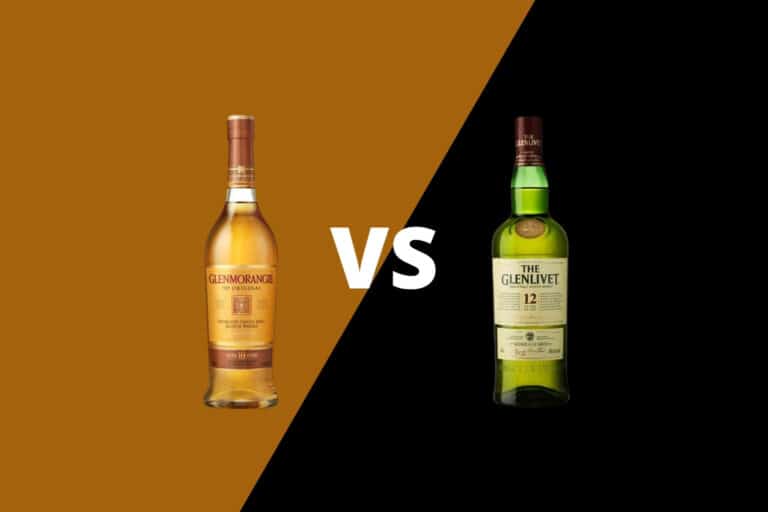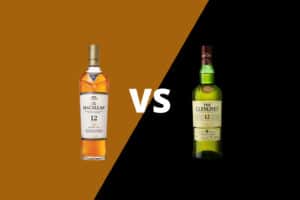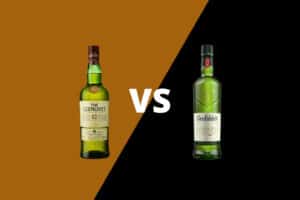Whisky lovers worldwide have a strong affinity for the two brands we’re looking at today — Glenmorangie and the Glenlivet.
In this post, we’ll look at their flavor profiles and everything that comes along with them — including history, fermentation, distillation, maturation, ownership and more.
So take a seat, grab a glass and let’s jump right in!
Table of Contents
History
Both historic single malt scotch brands have origins in the early 19th century.
The Glenlivet — Scots for Valley of the Deer — began legal distillation in 1823 — the same year the United Kingdom loosened its laws and made legal scotch distillation economically feasible. George Smith earned a distillation license, building a legal distillery in the valley where illicit distillation had been prevalent for centuries.
In 1843 Anne and William Matheson founded the Glenmorangie Distillery on the family farm. For at least 175 years, spirit has been distilled near the burgh of Tain, in the northern reaches of Scotland’s Highlands region near the coast along the Dornoch Firth.
Mash Bills & Fermentation
Both the Glenlivet and Glenmorangie are single malt scotch whiskies — meaning they are legally required to be made of 100 percent malted barley.
Pure spring water sources are an essential ingredient because of their use in the dilution of the finished product —which we will discuss during the production section — and because of the distinct environment it creates for yeast during the mashing and fermentation phases.
Both products utilize world-class water sources. For Glenmorangie, it’s the Tarlogie spring. And the Glenlivet utilizes Josie’s Well near the mineral-rich River Spey.
Springwater rich in minerals creates an environment in which yeast can interact to create byproducts that eventually will create opportunities for flavor compounds to be created during the various stages of the production process. The chemistry inside the mash tun and washbacks will vary based on the water’s alkalinity, pH and minerality.
During fermentation, yeast consume sugar molecules in the mash. They expel ethyl alcohol — the type consumable by humans — and byproducts called esters — over 100 different molecular acid chains that have been observed by scientists dedicated to unlocking some of the magic behind distillation.
Longer fermentation times often lead to the production of esters that are experienced as fruity — associated with the flavors of peach, citrus and pear. During fermentation, yeast produce a range of acidic esters as the environment changes from oxygen and sugar-rich to an ethyl-rich environment. This is described as the lactic phase of the ferment, and common byproducts of these stressed yeast conversions include propanoic acid and pentanol — identified by the tongue as peach — and acetic acid and amyl alcohol — experienced as ripe pear. As we’ll discuss in the next section, interaction with copper during the distillation phase and the shape and angle of the equipment as the vapors rise, fall and weave their way to the condenser may help clean or concentrate these esters based on the distiller’s specs.
Both the Glenlivet and Glenmorangie have relatively short distillation times of just over two days. The Glenlivet utilizes wooden washbacks — often called fermentation tanks in the United States — while Glenmorangie uses stainless steel. Often, ambient organisms like lactobacillus associated with the porous wooden surfaces contribute flavor compounds associated with malolactic fermentation.
Distillation & Production Techniques
According to United Kingdom Law, single malt scotch whisky must be produced using copper pot stills at a single distillery.
Glenmorangie’s ‘Distillers of Tain’ have produced whisky at the site for about 200 years. There, they utilize copper stills that are taller than the industry average. Especially during the distillation of single malt whisky, the size, shape and dimensions of the still lead to unique flavor attributes in the newmake spirit. Glenmorangie’s website boasts the tallest stills in Scotland, which is a claim that has been contested in recent years by the custom-built stills at the new Hollyrood Distillery in Edinburg, who have claimed that same title.
Today, the production team at the Glenmorangie Distillery is led by Director of Whisky Creation, Dr. Bill Lumsden — a venerable legend in the whisky industry.

Glenmorangie claims the giraffe as its’ spirit animal’ because of these tall stills — ‘with necks as tall as a giraffe’ — and angled lyne arm. They have even created a donation site dedicated to conserving the animal’s wild habitat, and the bottle purchased for review on this site came in elaborate giraffe-themed gift packaging. The new make spirit that comes off these tall stills is delicate and fruity — descriptors nearly universal when browsing tasting notes of the finished whisky.
The Glenlivet utilizes the more traditional and squat Speyside-style copper stills — often called lamp glass stills because of their resemblance to old-fashioned gas lamps. Glenmorangie’s large facility boasts an impressive 14 stills, seven wash stills that perform a stripping run on the wort, and seven spirit stills that convert low wines into new make spirit.
Water is known to brewers and distillers as perhaps the most influential ingredient used in their craft.
Like many historic whisky production sites — whether in the British Isles, North America — the Glenmorangie Distillery’s campus was built around the limestone and sandstone-filtered water source — the Tarlogie Springs. Likewise, the Glenlivet distillery is one of the dozens of production sites that dot the hillside around the high-quality River Spey and pulls its water from Josie’s Well, which offers additional limestone-rich filtered spring water.
This water source has minerals that give the ‘hard’ water qualities that are beneficial during the mashing, fermentation, maturation and dilution of the finished product. Incredibly, brewers and distillers have recognized the importance of water for hundreds if not thousands of years — long before the science behind the mineral and chemical reactions taking place caught up! Today, water can make up to 45 percent of a finished bottle of 80-proof whisky, making it one of the most critical ingredients in the finished product.
Here, we should make note of the whisky regions.
Knowledgeable scotch enthusiasts can tell you Scotland has been divided into five whisky production regions — the Highlands, the Lowlands, Campbeltown, Speyside and Islay.
Both Glenmorangie and the Glenlivet are labeled as single malt Highland whisky. But the Glenlivet is located within the region designated as Speyside. This is possible because the Speyside region was once part of the Highlands and only became its own region in the 21st century. So today, producers within the area surrounding the River Spey have the choice of labeling their whisky as Highland or Speyside whisky. Perhaps because the the Glenlivet has been labeling its single malt product as Highland whisky since the mid-nineteenth century, they continue to hold that designation on the label. Despite the label, the Glenlivet is often considered the quintessential Speyside malt.
Maturation
Both of these fine products are age statement whiskies — which means they have a legally-binding claim as to the length of maturation in oak.
The Glenlivet 12 is aged for 12 years, while Glenmorangie 10 is aged for 10 years — meaning the youngest barrel used in the batch blend has been aged for at least that length of time. Much older barrels will often be added to create complexity and structure and keep the product consistent from batch to batch.
Influenced by global supply chain economies of scale, most scotch whisky is matured in American oak casks — specifically the ex-bourbon cask or barrel. These two offerings are no exception.
Ownership, Price Point & Value
Glenmorangie is owned and produced by the Glenmorangie Company, with Paris-based conglomerate LVMH Moët Hennessy Louis Vuitton owning a significant stake in the company.
Glenmorangie 10 Years Old runs for about $45 for a 750mL bottle at 80-proof, or 40 percent ABV.
The Glenlivet is produced by Pernod Ricard, the France-based international spirits maker.
The Glenlivet 12 Years Old runs for about $52 for a 750mL bottle at 80-proof, or 40 percent alcohol by volume.
Tasting Notes
The Glenlivet 12-Year-Old Single Malt Scotch Whisky
Description: In the glass, the Glenlivet 12 has a medium hue, with the color of burnished copper. Pronounced legs, especially at 80-proof.
Nose: Honey and heather, fruity notes of raisins and dried figs, sandalwood, vanilla, coconut with a slight citrus note.
Palate: Oaky vanilla and cinnamon, honey, toffee, raisins, caramel and a hint of smokiness
Finish: Floral clover notes and coconut, cinnamon and pepper with lingering honey notes.
Glenmorangie The Original 10-Year-Old Single Malt Scotch Whisky
Description: In the glass, Glenmorangie the Original has slight legs and an amber color with light yellow hue at 80-proof.
Nose: Prominent peach and pear notes. Slight peppery note. Malty cereal, bread. Cherries. Citrus peel. Vanilla. Honey and caramel.
Palate: Peachy. Pear notes. Floral. Vanilla, marzipan, white chocolate.
Finish: Honey. Caramel. Toffee. Slight cracked pepper. Chocolate.
Verdict…
New to the scotch whisky category? You could do worse than try these two products, with light and floral notes of sweet fruit and a mellow finish.
And because of their world renown, they are two relatively affordable bottles — especially considering 10- and 12-year-old whisky products in the single malt category. So, whether you’re a whiskey noob or an experienced connoisseur, the affordable price and value within the price range offer an extraordinary expansion to your personal home bar. If you’re looking for an affordable, high-quality whisky, this should be your go-to side-by-side tasting.
















